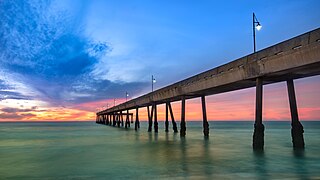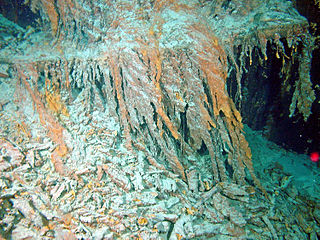
Pacifica is a city in San Mateo County, California, on the coast of the Pacific Ocean between San Francisco and Half Moon Bay.
Pacifica Foundation is an American non-profit organization that owns five independently operated, non-commercial, listener-supported radio stations known for their progressive/liberal political orientation. Its national headquarters adjoins station KPFK in Los Angeles, California.

Halomonadaceae is a family of halophilic Pseudomonadota.

Pacifica State Beach is the southernmost of Pacifica, California's large beaches. It is a 0.75-mile-long (1.21 km) crescent-shaped beach located at the mouth of the San Pedro Valley in downtown Pacifica off State Route 1, in San Mateo County.
Cobetia marina is a Gram-negative halophilic marine bacterium.

Halomonas is a genus of halophilic (salt-tolerating) bacteria. It grows over the range of 5 to 25% NaCl.

GFAJ-1 is a strain of rod-shaped bacteria in the family Halomonadaceae. It is an extremophile that was isolated from the hypersaline and alkaline Mono Lake in eastern California by geobiologist Felisa Wolfe-Simon, a NASA research fellow in residence at the US Geological Survey. In a 2010 Science journal publication, the authors claimed that the microbe, when starved of phosphorus, is capable of substituting arsenic for a small percentage of its phosphorus to sustain its growth. Immediately after publication, other microbiologists and biochemists expressed doubt about this claim, which was robustly criticized in the scientific community. Subsequent independent studies published in 2012 found no detectable arsenate in the DNA of GFAJ-1, refuted the claim, and demonstrated that GFAJ-1 is simply an arsenate-resistant, phosphate-dependent organism.
Halomonas venusta is a Gram-negative halophilic Pseudomonadota, first described as Alcaligenes venustus and later reclassified as Halomonas venusta, along with other species when the genera Deleya, Halomonas, and Halovibrio and the species Paracoccus halodenitrificans were unified into a single genus, Halomonas, while the genus Zymobacter was placed in the family Halomonadaceae. The name stems from the Latin noun venusta which means "lovely" or "beautiful". It was originally isolated in marine water from Hawaii.
Halomonas alkaliphila is a Gram-negative halophilic Pseudomonadota. Its specific epithet stems from the Arabic word alkali (al-qaliy), the ashes of saltwort and the Latin adjective philus -a -um, meaning "friend" or "loving": loving alkaline media.

Halomonas titanicae is a gram-negative, halophilic species of bacteria which was isolated in 2010 from rusticles recovered from the wreck of the RMS Titanic. It has been estimated by Henrietta Mann, one of the researchers that first isolated it, that the action of microbes like Halomonas titanicae may bring about the total deterioration of the Titanic by 2030. While the bacteria have been identified as a potential danger to oil rigs and other man-made objects in the deep sea, they also have the potential to be used in bioremediation to accelerate the decomposition of shipwrecks littering the ocean floor.
Halomonas subglaciescola is a Gram-negative halophilic bacterium. It was first isolated from an Antarctic, hypersaline, meromictic lake, but has since been found in other environments, such as fermenting seafood. It has a largely oxidative mode of metabolism and it is motile through peritrichous flagellation. This species doesn't utilise glucose, and its type strain is ACAM 12.
Halomonas ventosae is a moderately halophilic, denitrifying, exopolysaccharide-producing bacterium. Its type strain is Al12T.
Halomonas organivorans is a halophile able to degrade aromatic compounds. It's considered a potentially useful bacteria for decontamination of polluted saline habitats. Its type strain is G-16.1T.
Halomonas desiderata is an alkaliphilic, halotolerant and denitrifying bacterium first isolated from a municipal sewage works.
Halomonas alimentaria is a bacterium first isolated from jeotgal, a traditional Korean fermented seafood, hence its name. It is Gram-negative, moderately halophilic, non-motile and coccus- or short rod-shaped, with type strain YKJ-16T.
Halomonas johnsoniae is a halophilic bacteria first isolated from the environment surrounding dialysis patients. It is closely related to H. magadiensis.
Halomonas hamiltonii is a halophilic bacteria first isolated from the environment surrounding dialysis patients. It is closely related to H. magadiensis.
Halomonas meridiana is a bacterial species discovered in 1990 in the hypersaline lakes of Vestfold Hills, Antarctica.
Halomonas elongata is considered the type species of the genus Halomonas. It is a chemoorganotrophic, halophilic bacterium first isolated from a solar salt facility located in Bonaire, Netherlands Antilles.
Cobetia amphilecti is a Gram-negative, aerobic, oxidase-negative, catalase-positive, bacterium. It has non-pigmented, rod-shaped cells, 0.8–0.9 µm in diameter and 1.1–1.3 µm long, motile by means of one polar and/or two or three lateral flagella. Growth is observed in 0–20 % NaCl with an optimum at 5% NaCl, and at 4–42 °C with an optimum at 37 °C. Growth is slow in the absence of NaCl and in the presence of 0.5% NaCl. Grows at pH 4.5–10.5 with an optimum at pH 6.5–8.5. Negative for hydrolysis of gelatin, starch, chitin, aesculin, xanthine, hypoxanthine and Tween 80. Negative for H2S production.




